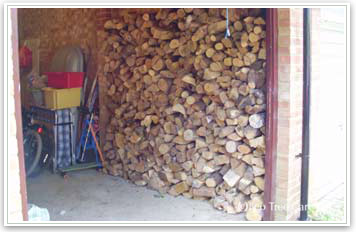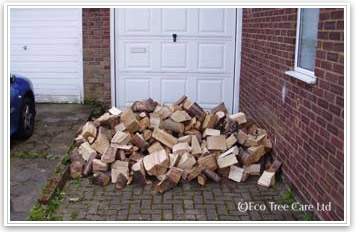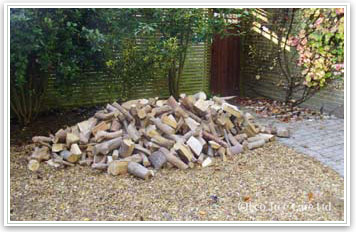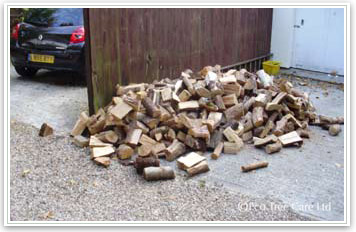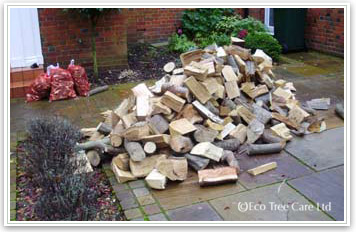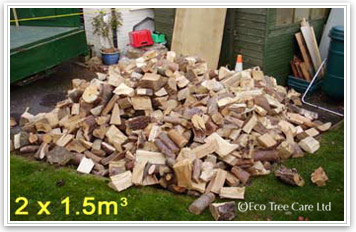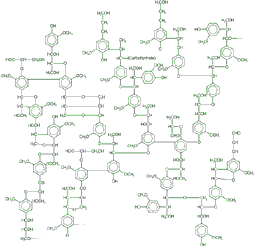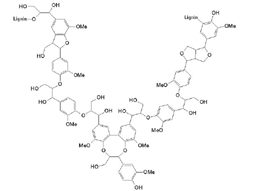Archive page - Service no longer offered
This website began in the summer of 2003 and so has seen much content over time. We have made a decision that, for now, rather than delete pages that are no longer being updated, or are for services that we no longer offer, we would instead place them in this archive section to serve as a portfolio, library & as a history
Seasoned Firewood Logs
Firewood from Sustainably Managed Woodland
Local Firewood Delivery
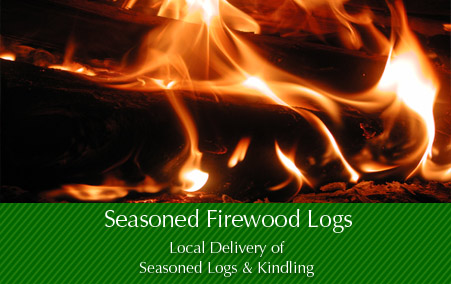
Eco Tree Care Ltd - Firewood Information
Things to consider when looking at local firewood log suppliers and the prices
![]() All our Firewood is cut from local sustainable sources
All our Firewood is cut from local sustainable sources
![]() Our Firewood is not imported from Eastern Europe
Our Firewood is not imported from Eastern Europe
![]() Our Firewood is seasoned and batch tested with a humidity meter prior to delivery
Our Firewood is seasoned and batch tested with a humidity meter prior to delivery
![]() Our Firewood can be selected to suit the size of your fire or woodburner
Our Firewood can be selected to suit the size of your fire or woodburner
![]() We can help you with the moving and stacking of your Firewood as an additional
service
We can help you with the moving and stacking of your Firewood as an additional
service
![]() We can give advice on Firewood storage options and how to handle for maximum
heat efficiency
We can give advice on Firewood storage options and how to handle for maximum
heat efficiency
![]() We have even have been known to build beautiful bespoke log stores from our
natural timber
We have even have been known to build beautiful bespoke log stores from our
natural timber
![]() We are a local family-run business
We are a local family-run business
![]() We are nice to do business with aiming to be polite, professional and puntucal
We are nice to do business with aiming to be polite, professional and puntucal
![]() Our customers come back time and time again because we are reliable
Our customers come back time and time again because we are reliable
![]() We may not be the cheapest for firewood in an area full of woodlands and woodsmen...
We may not be the cheapest for firewood in an area full of woodlands and woodsmen...
![]() But we always aim to provide top quality seasoned firewood with a friendly
and informed service
But we always aim to provide top quality seasoned firewood with a friendly
and informed service
Eco Tree Care Ltd - Firewood Prices
Mixed Seasoned Firewood 1.5m3 approx. (2 Builders Bags)
As they come from the log pile - unsorted = £
Selected Seasoned Firewood 1.5m3 approx. (2 Builders Bags)
Hand selected or specifically cut for customers who perhaps have small wood burners or fireplace and have an upper or lower limit on their required size = £
Firewood in Net Sacks
Our Net Sacks are of the larger variety at 78cm x 48cm (2'8" x 1'7") when empty and laid flat suitable for those with limited storage or challenging access = £ per bag
All our prices include VAT at 5% for fuel
Where our Firewood came from...
And why it was good...
Predominately our firewood came from coppice woodland, meaning
that areas of woodland trees are cut on a rotation. It was effectively harvested
just like, and in fact, as a crop. The species of tree that make up a coppice
woodland are particularly adept at re-growing from a cut stump and so the
firewood we cut grows back over a number of years (10-30 years).
In the process of harvesting firewood from cutting coppice the woodland floor
is flooded with light until the trees grow back up and the canopy closes over.
This provides the opportunity for different species of flowers, insects, birds
and mammals to move in and the biodiversity of the woodland is increased.
By coppicing only a certain area each year on a rotation a mosaic of woodland
with a different age and structure is created which means that we create and
provide valuable 'edge effects' or 'ecotones'.
So not only does using our firewood mean that you have a near carbon neutral fuel, our firewood is directly benefiting wildlife and increasing the biodiversity of the woodlands where we work.
See the Woodland Management Web Page Coppicing section.
Firewood in the News
Radio 4 - Firewood
- You and yours - Listen again
Sales of wood burning stoves in 2008 are 40% up - Can you scavenge your own
firewood??
"Firewood company's roaring trade"
http://news.bbc.co.uk/1/hi/england/bristol/7798258.stm
"Firewood thefts threaten wildlife"
http://news.bbc.co.uk/1/hi/wales/north_west/6175545.stm
"Wood collecting tradition to end"
Watch
- BBC News Clip
Read
- Related web article
Firewood Logs in Net Sacks
Net Sacks of cut and split firewood logs are for sale at £6.50 - Minimum 10 bags for free delivery, applies to customers in our local area. Any less than 10 bags and a delivery charge may apply depending on your location or you can arrange pick-up from Cutlers Farm, Chilham)
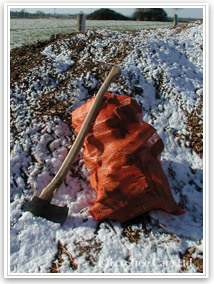
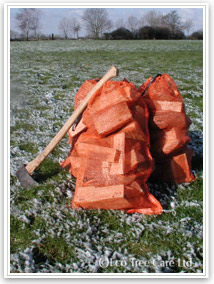
Note:
Our new orange bags are considerably larger than the green bags hence the
£6.50 price tag.
These
bags are much bigger than typical log bags found on
garage forecourts or in the
small supermarkets
They are also filled right up.
Bag size when empty and flat is 78cm x 48cm (2'8" x 1'7")
Kindling in Bags
Bags are slightly smaller than the log bags at 50cm x 40 cm when flat.
We have two grades of kindling on offer. Many of our customers find that a combination of Woodsman Kindling and Cut Kindling to be a good mix.
"Woodsman
Kindling" - Unashamedly sieved scraps from the barn floor.
These Kindling bags are made up of the small bits of wood, bark, and twigs
that result from the log splitting operations. We collect up the valuable
left over's and sieve it using a charcoal grader and bagger to remove sawdust
and shavings. This gives an excellent fire lighting mix that we use personally
in our homes. It is what a woodsman would use to start their fire. These we
sell at £
Cut
Kindling
Some people prefer the cut type of kindling where logs are split down further
into smaller sticks.
Bags of cut kindling for sale at £ can be added
onto any order of bags or loose loads.
Firewood Logs sold as a Loose Load
If you are able to accommodate it your firewood can be delivered as a loose load of logs. To load up and measure out our loose loads we use bulk bags (see photo) 2 x bulk bags is approx 1.5m3 . This is our standard load. For those that want a smaller volume of logs then we please see the firewood log bags above.
"Mixed" Loose Loads of Firewood - Suitable for Open fires & large wood burners
Mixed loads of firewood we define as straight
from our log piles, no sorting. Log sizes range from small (approx 15cm/6")
to large logs (approx 45cm/18") as the extremes. The vast majority of
the logs will be approximately 30cm/12ft or there abouts. Loading into bags
is generally mechanical and so there is no sorting of logs.
We sell 1.5m3 of mixed seasoned firewood for £
"Selected" Loose Loads
of Firewood - Small woodburners, small open fires, pizza ovens e.t.c.
Selected loads of firewood we define as logs of a certain
selected size, maximum size or certain types of wood.
Some of our customers have small wood burners or small open fires, or request no conifer if the wood is being used to cook food. We can accommodate such requests defining these loose loads as "Selected". Their is an increased cost becasue of the extra time taken to sort through the log pile. Loading into the bulk bags will be by hand in order to select the desired firewood logs.
We sell 1.5m3 of Selected Seasoned firewood for £
Note: We tip the logs out of the bulk bags on delivery so we can re-use them. If you would like us to leave the bags with you then we ask for a £5 deposit, refundable on return of the bag next delivery.
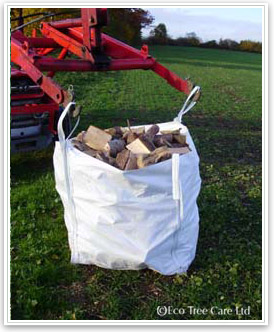
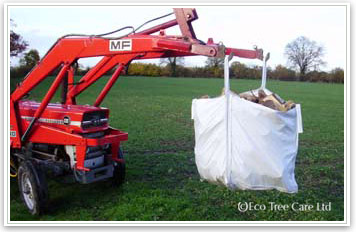
Bulk Bags used to measure loose loads of firewood
2 x Bulk bags = approx 1.5m3
Examples of Standard Delivery of 2 Bulk Bags
|
Note: The approx 1.5m3 is the combined volume of two bulk bags. The volume of the logs if stacked neatly and carefully will undoubtedly be less than 1.5m3. For clarification we are selling volumes of bulk bagged logs not actual volumes of wood prior to splitting or when stacked neatly.
Firewood Delivery is free to all customers in our local range. For customers outside our working range a delivery charge will be asked for, depending on size of load. For large loads (4.5 cubic metres and above) a delivery charge may not be charged if not too far out of our area
Pick-up
Occasionally it may be possible arrange a pick-up of our Firewood logs from
the yard. This must be by prior arrangement only and my not always be possible
as our yard is not open to the public.
* Note: Firewood delivery is to the drop off point only i.e. to where the delivery vehicle can back up to. Very occasionally we may be able to help carry bags or stack logs. In cases where unloading requires a distance to be carried or wheel barrowed, up/down steps, through houses, e.t.c. we would have to ask for a donation for our time and extra work involved. If this is the case please tell us before we deliver so we may bring a wheelbarrow or carrying bins e.t.c.
Firewood Delivery to groups of neighbours
Do you have neighbours who also use firewood logs to heat their homes? If
so we encourage shared deliveries of logs to save on our time and more importantly
the fossil fuel used in delivery.
The Importance of Seasoning Firewood
It can not be over-emphasised that the key to good firewood and therefore a good fire is well seasoned logs. Seasoning can only happen with time and dry airy conditions. The water content can be as high as 45 - 50% in freshly cut logs. Well-seasoned firewood will have a moisture content of around 20-25%.

Well seasoned logs will heat
your home better
Poorly seasoned logs will burn slowly and inefficiently. A certain amount
of the heat of combustion will be used up drying out the wood before it will
burn. The fire will be cooler, and will produce more smoke. The smoke produced
will contain more particulates and complex hydrocarbons further reducing the
efficiency of the conversion of wood to heat.

Well seasoned firewood produces
less pollution
Dry firewood logs will burn with very little smoke. They will burn with a
hot and efficient flame to give carbon dioxide and heat. Less smoke, less
particulates, means less pollution.

Well seasoned firewood is better for your chimney
When logs are burnt un-seasoned they will burn cooler and with much more smoke.
The cooler the fire the less the chimney will heat up. A cool chimney and
chimney flue will result in condensation of the volatile components of smoke
onto the inside of the chimney. The resulting deposit will consist of creosote,
which is formed by the flammable particles in the smoke remaining unburned.
This is because there is not enough heat in the fire, resulting in incomplete
chemical reactions. Creosote can eat away at the linning of your chimney.

Well seasoned firewood helps prevent chimney fires
As above un-seasoned firewood can increase the rate at which unburnt chemicals
are deposited on the lining of your chimney. It is possible that these deposit
can re-ignite resulting in a chimney fire. Not only can this damage your chimney
but in worst cases it can spread, it is then no longer a chimney fire but
a house fire. Before moving to Chilham, in Kent, Martin also worked as a retained
firefighter in Much Hadham, Hertfordshire and regularly is called to chimney
fires during cold weather. Especially dangerous for thatched houses. Always
burn seasoned firewood and have your chimney regularly swept by a chimney
sweep.
The Combustion of Firewood - "The technical bit"
Martin originally graduated with a degree in Chemistry from the University of Nottingham before starting life as a woodsman 6 years after graduation. Hence the technical explanation below comes from a need to understand what is happening at a chemical level when burning firewood.
Although the molecular structure of wood is complex, the proportions of the constituents, carbon, hydrogen and oxygen is remarkably constant. The proportions being - carbon 50%, hydrogen 6% and oxygen 44%. These constituents are essentially 3 polymers...
Cellulose C6H10O5
Lignin C9H10O3 (OCH3) 0.9 - 1.7
Hemicellulose C5H8O4 e.g. Xylan
Cellulose C6H10O5,
Lignin C9H10O3
(OCH3)
0.9 - 1.7, Hemicellulose C5H8O4
e.g. Xylan. They co-exist together in varying proportions depending on the
species of wood, also in the mix are varying resins of different compositions
and small amounts of mineral substances that yield ash when burned. What follows
is a more detailed analysis of what makes up your firewood. What exactly are
we burning when we put our logs on our fires?
|
(C6H10O5 ) Cellulose is a polysaccharide of beta-glucose.
In other words, it is a repeating chain of a particular type of glucose
sugar molecule, to form a polymer. (Poly - 'Many'; -saccharide
'sugar'). The chains are in the order of 7,000 - 15,000 glucose
molecules per polymer. Lignin and cellulose, considered together, are termed lignocellulose, which is essentially wood. It is argued to be one of the most common biopolymers on our planet. In combination with lignin and hemicellulose, it is found in all plant material. Cellulose is flexible in comparison to lignin which is rigid. It like the steel rods within reinforced concrete. It gives flexibility to the structure. It is strong in tension, weak in compression. This is demonstrated within rotting trees. A 'white rotter' is a class of fungi that eat the lignin as it goes, thus leaving just the white cellulose behind. The resulting white portion is, a very curious, flexible wood with a rubbery feel. (See Portable Sawmilling - North Mymms Oak a large mature oak eaten away by a Ganoderma fungi) Cellulose is the most abundant form
of living terrestrial biomass with an estimated annual production of
1.5 x 10 to the power of 12 Tonnes (1,500,000,000,000 tonnes)
(C9H10O3 (OCH3) 0.9 - 1.7)
Lignin is a complex, highly cross-linked aromatic polymer that is most commonly derived from wood and is an integral part of the cell walls of plants. Therefore in our consideration of the burning properties of firewood it is a major player. Unlike cellulose, which has an ordered and predictable molecular structure, lignin consists of various types of substructures which appear to repeat in a random manner. The schematic diagrams to the right show portions of it's complex structure. Lignin has several unusual properties as a biopolymer, it has a network structure and it lacks a defined primary structure. In reality the cross linking means that there are covalent chemical bonds between different parts of the molecule so it is impossible to say where the molecule starts and finishes. Where the molecule starts and finishes makes no sense, it is a network. It is one of most abundant organic compounds on earth after cellulose. When talking about wood we know that Lignin makes up about one-quarter to one-third of it's dry mass. Lignin fills the spaces in the cell wall between cellulose, hemicellulose and pectin components. It is also covalently linked to hemicellulose as well as within it's self. Lignin is rigid in it's nature so it is what gives mechanical strength to the cell wall and therefore the entire plant. In our reinforced concrete metaphor, it is the concrete around the flexible steel internal rods. It is weak in tension, strong in compression. Therefore it is particularly abundant in compression wood, but scarce in tension wood. This is demonstrated within rotting trees. 'Brown Rotters' are a class of fungi that eat away at the cellulose in the wood of our tree. What is left is the brittle brown lignin. When poked and pulled it breaks away in 'blocks' or more correctly 'rings'. E.g. Piptoporus betulinus fungi Burning lignin yields a range of products, of which the most characteristic ones are methoxy phenols. In cooking, lignin, in the form of hardwood logs, is an important source of these chemicals which impart the characteristic aroma and taste to smoked foods. It is generally considered better to have more hardwood than softwood in the firewood mix. See later for our evaluation of different types of wood and their properties when used as firewood. Lignin yields more energy when burned than cellulose.
A hemicellulose can be any of several heteropolymers (matrix polysaccharides) present in almost all cell walls along with cellulose. While cellulose is crystalline, strong, and resistant to hydrolysis, hemicellulose has a random, amorphous structure with little strength. Hemicellulose is a polysaccharide, like cellulose, but otherwise has no chemical relationship to cellulose. It consists of shorter chains - around 200 sugar units as opposed to 7,000 - 15,000 glucose molecules per polymer seen in cellulose. In addition, hemicellulose is a branched polymer, while cellulose is unbranched. Hemicelluloses include xylan, glucuronoxylan, arabinoxylan, glucomannan, xyloglucan, arabinogalactan II and galactomannan to form part of the plant cell wall matrix. Xylan, also known as wood gum, is a yellow, water-soluble, gummy polysaccharide found in plant cell walls. It is a polymer of xylose. Xylose, C5H10O5, which is also known as Wood Sugar is a 5 carbon ringed molecule. It is found in the embryos of most edible plants, and is said to be one of the eight sugars essential for human nutrition. Xylans are almost as ubiquitous as cellulose in plant-cell walls and contain predominantly beta-D-xylose units linked as in cellulose. Some xylans contain other sugars, such as L-arabinose, but they form branches and are not part of the main chain. Xylans are of little commercial importance. Glucuronoxylan is another cell-wall polysaccharide. It contains glucuronic acid and xylose as its main constituents, having a beta (1-4)-xylan backbone, with 4- O -methylglucuronic acid side-chains. Arabinose and acetyl side-chains may also be present. Studies have demonstrated that glucuronoxylan gived a certain amount of plasticity as a constituent of wood fibres.
SummaryIn truth, where it is possible to isolate various components of wood. They are all molecules with organic chemistry so there are chemical and covalent bonds interlinking them all to make what we know as wood. The different species of wood will have different relative amounts of these components, with different interlinking and different side chains on the parent molecules in varying positions and orientations.
PhotosynthesisThe polymers making up wood have been made by the tree by trapping solar energy from the sun, and using this energy to combine Carbon dioxide from the air with water. This is done by chlorophyll in the leaves by the process of photosynthesis.
Carbon dioxide and water molecules are very stable molecules i.e. the atoms in the molecules 'like' to be combined together in this particular 'pattern' or 'orientation'. Carbon dioxide and water are simple molecules with simple bonds and not many atoms. In contrast the polymers of wood are energy intensive molecules, they contain many many atoms and are arranged in complex patterns, with many bonds. They are 'full' of energy, and exist only because of the abundant energy from the sun that has been used to create them. The plant has effectively locked up this solar energy and stored it as complex wood molecules. Essentially all wood, regardless of species, contains roughly the same amount of energy per kilogram. The variable is only the density. However different species do have different burning properties - discussed later. The rate of photosynthesis is dependant on the intensity of light, the concentration of carbon dioxide, and the temperature. When we burn firewood we are effectively reversing this photosynthetic reaction to release the sun's energy as heat, light and sound. Consider this when sitting in front of your open fire... When burning our firewood you are releasing energy from our star, the sun - this star energy has been released as photons during the nuclear fusion of Hydrogen into Helium which has then traveled 92,950,000 miles through space taking 8 minutes 19 seconds (Ref.). It has then struck a leaf containing chlorophyll on a tree, which happens to be in its position on the planet that is in 'daylight' during the earths daily rotation. These photons are 'trapped' as they are used to convert carbon dioxide and water into a complex high energy molecules and laid down to be stored as wood. After many years the tree has found itself in a situation whereby it has been removed and cut up into logs for firewood. The log is then stored for at least a year so excess water is expelled. When the log has seasoned it is fit to be called firewood and is delivered to you where it is stored in your log store until such time that it is cold enough for you to wish to make a fire. The firewood is arranged and energy is put in as a flame. The heat of the flame causes the complex molecules to split up and release flammable gases which burn with oxygen to give carbon dioxide and water. The trapped star energy is released as heat, light and sound warming the living room and the spirit. Lovely!
|
Burning properties of Firewood
A species by species consideration
A brief synopsis of various tree species and their qualities when split and cut into firewood. Each description contains a 'Firewood Burning Properties' section giving a series of adjectives to describe the wood when burnt.
Firewood burning connoisseurs may select which of the logs they have available to add to their fire at any given time. Knowing the burning properties of different firewood means that if a fire needs quickening up a bit or slowing down a particular log will do just the job. Or if a log is a poor or mediocre burner then it may do well to combine it with logs that will keep it going. It is worth remembering that all wood is trapped solar energy and given the right conditions and seasoning can be efficiently made to release it.
Next is a 'Log Frequency' giving a rough guide to the chances
of finding that species in our deliveries of logs from our seasoned log pile
for supply during 2012. This is based on the predominance of the woodland
management projects we have been doing within Cutlers Wood in Chilham and
the woodland and tree work within the local area that has gone into creating
this seasons firewood log pile. Ranging from 1 - Rare up to 10 Most Likely.
Alder
- Alnus glutinosa
As a firewood alder is not considered to be excellent for it's heating properties.
It is a soft porous wood and tends to burn quickly with a bright flame. It
is said to give off relatively little heat, but this is difficult to assess
when in the firewood mix. Because it burns quickly it is not a bad log to
have when mixed with slow burning firewood species like oak and beech and
can be useful when starting a fire. From an aesthetic point of view it is
a good looking log because of it's rich pinky brown colour. A nice one to
have by the fire.
Firewood Burning Properties - Light,
quick, bright
Log frequency
: 1
Apple
- Malus spp.
Apple wood is considered to be a real gem of the firewood selection. It is
not particularly common when compared to some of the other native trees that
we come across in our working life although in our region around Chilham there
are of course many orchards and so we hope that in the future we will be able
to increase the predominance of this species. If you are lucky enough to find
some in your firewood delivery then keep it for special occasions. It gives
off a beautiful smell. Also for this reason it is highly prized for cooking
food because of the most excellent flavour that it gives to food and it also
burns with a soft flame, glowing hot rather than with big flames.
Firewood Burning Properties - Fragrant,
soft, solid
Log frequency
: 2
Ash
- Fraxinus excelsior
Ash is arguably the best firewood. It burns very well with a strong consistent
and bright flame. Ash logs produce an excellent heat and are easy to light.
There is a rhyme "Ash, mature or green, makes a fire for a Queen."
and another "But Ashwood wet and Ashwood dry A King may warm his slippers
by". (See the firewood rhymes below) Ash as firewood indeed does burn
unseasoned (however the same considerations apply to burning unseasoned wood
as any others - see above). Not only does ash burn well, it has a lovely smell
when burning and it splits very cleanly and easily. The reason ash is a good
firewood is due to the high content of oils in the wood. Ash is in the same
family as olive trees - The Family Oleaceae.
Firewood Burning Properties - Easy,
keen, warming
Log frequency
: 8
Beech -
Fagus sylvatica
Beech is a excellent firewood, it burns long and with a high heat. It is dense
and relatively slow burning. We find that beech does best when combined with
other faster burning logs as just on its own it can burn just a bit too slow.
A beech log will be heavy and solid, as a firewood its carries on these qualities.
Firewood Burning Properties - Solid,
dependable, bright, hot, slow
Log frequency
: 6
Birch
- Betula spp.
One of our favourite firewoods and a good looking log too. Sometimes we have
had requests for silver birch logs to have just for show by the fire as they
are so pretty. It splits easily and creates a good fire with a bright hot
flame. Just like it grows and dies it burns similarly quickly so it is good
mixed with slow burners like oak and beech logs. The bark, which sometimes
on the larger logs, peels off easily makes an excellent fire starter. This
is the wood to select first if trying to light a fire out of doors and everything
is wet. It can be burned unseasoned and will light, eventually, even when
wet.
Firewood Burning Properties
- Fast, bright, forceful
Log frequency
: 8
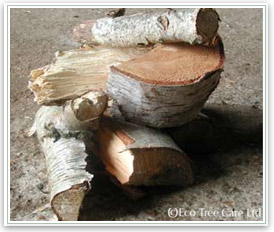
Blackthorn
- Prunus spinosa
A very heavy firewood. It is slow to light when a large split log, easier
when small and in the round, but once alight gives a strong dependable flame
with plenty of heat. Best added to the fire once established. Small round
logs are shiny black bark, smooth and tough looking.
Firewood Burning Properties
- Fast, bright, forceful, tough
Log frequency
: 2
Cedar
- Cedrus spp.
Wonderful smelling and resinous wood. The logs burn with a soft flame
which is steady and hot. It is a good wood to cook food over because of the
absence of large flames.
It does occasionally spit, but not badly. A fire with cedar logs will have
bright red glowing embers.
Firewood Burning Properties
- Fragrant, soft, hot, glowing
Log frequency
: 1
Cherry
- Prunus avium (spp.)
A slow burning firewood but giving out lots of heat. Good looking logs with
a rich heartwood colour. Bark on larger logs can peel off to provide useful
fire starting material. Logs of cherry split easily into firewood, heavy,
dense, solid. An excellent log, another of our favourites. Pleasant scent.
Firewood Burning Properties
- Fragrant, soft, hot, glowing
Log frequency
: 2
Douglas Fir
- Pseudotsuga menziesii
Slow Burning with lots of heat, Splits easily. Solid and dense.
Firewood Burning Properties
- Slow, hot, dependable
Log frequency
: 1
Elder
- Sambucus nigra
Elder burns very quickly and with little heat, the wood is light. It also
burns with a cloying smoke. Traditionally burning elder was said to be bad
luck or would bring evil spirits into the house. It may be that it not being
a good burning wood, and very smoky contributed to this folk lore. We don't
consciously have elder in our firewood log mix. All attempts are made to prevent
Elder being added to the firewood log pile. Very rarely an elder stem may
inadvertently find its way into the pile, but this shouldn't happen so you
shouldn't find elder in your mix. If you have a woodburner it is not such
a problem, should be avoided with an open fire.
Firewood Burning Properties
- Quick, smokey, poor
Log frequency
: 0
Elm
- Ulmus glabra
Elm logs need to be seasoned extremely well. The famous firewood rhyme says
that Elm burns like smoldering flax. The other rhyme says that it burns like
'churchyard mould'. The reason for this is that when a live elm tree is freshly
cut, the wood has one of the highest water contents. Very often this is not
a problem as it usual for the elm logs in the firewood pile to come from dead
elm trees, which have reached a certain size before succumbing to Dutch Elm's
disease, so they have often air seasoned for many many years as dead trees
before being cut down. Dead elms are very often seen in overgrown hedgerows,
straight poles with stag-headed branches, rarely over 15 cm in diameter.
Firewood Burning Properties
- Slow, smouldering
Log frequency
: 1
Eucalyptus
- Eucalyptus spp.
A good burning log but must be seasoned properly. This is because the
wood when fresh has a high water and oil content. For us it is very difficult
to split as the wood fibres are stringy and often the trunk and branches grow
with a twist. We try to split it into firewood as soon after cutting down
as possible as it is relatively easier to split when fresh. Also logs only
start to season properly after they have been split, and as this wood needs
proper seasoning before use the earlier the better all round. The bark is
pretty and when burnt does give off the characteristic eucalyptus smell. Eucalyptus
logs have been said to be 'explosive' if burnt unseasoned, due to pockets
of oils, not sure how accurate this is, but we have heard that it destroyed
a clay chimenea when some unfortunate person tried burning eucalyptus logs
from a tree they had only recently cut down. Make sure it is seasoned.
Firewood Burning Properties
- Fast, keen, unpredictable
Log frequency
: 0
Field Maple
- Acer campestre
An excellent firewood. Field maple logs are dense, solid and very heavy, they
burn well when seasoned.
Firewood Burning Properties
- Clean, hot, bright
Log frequency
: 3
Hawthorn
- Crateagus monogyna
Hawthorn logs make excellent firewood, dense, close grained & solid. One
of the best. Because of the
Firewood Burning Properties
- Hot, Solid, Slow, dependable.
Log frequency
: 2
Hazel
- Corylus avellana
A pleasure to burn, nothing special but certainly not bad - middle of the
road firewood
Firewood Burning Properties
- Quick, light, bright
Log frequency
: 7
Holly
- Ilex aquifolium
An usual wood, creamy and extremely dense and hard. Holly logs do indeed burn
'like wax'. (See the firewood rhymes below). It burns relatively slowly compared
to other firewoods.
Firewood Burning Properties
- Slow, consistent
Log frequency
: 2
Hornbeam
- Carpinus betulus
An excellent firewood, dense and very hard. It gives out a phenomenal amount
of heat, burning easily but slowly. It is a common coppice tree in Hertfordshire
and Essex, so is quite commonly seen as firewood in our region. Reputably
can be burnt half green, but will fizz and hiss water out of the ends, it
does take a lot to season hornbeam totally. Makes excellent hardwood charcoal.
Firewood Burning Properties
- Hot, slow, easy, confident
Log frequency
: 6
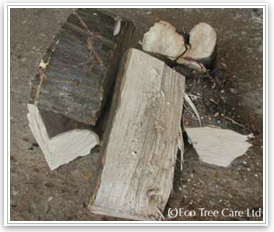
Horse Chestnut
- Aesculus hippocastanum
A light creamy wood which gives good heat and a low flame, can spit a little,
a worthy log when well seasoned. Can be a difficult log to light if even a
little green. Not a brilliant firewood.
Firewood Burning Properties
- Warm, gentle
Log frequency
: 1
Larch
- Larix spp.
A fairly good firewood when well seasoned, does have a tendency to crackle
and spit otherwise.
Firewood Burning Properties
- Crackling, atmospheric, bright
Log frequency
: 2
Laurel
- Prunus laurocerasus
A hard wood log, burns well, in common with the others of the Prunus genus
(blackthorn, cherry, almond e.t.c.). Has a bright clear flame, a nice log
to have in the firewood pile
Firewood Burning Properties
- Bright, clear
Log frequency
: 1
Lime
- Tillia spp.
Not the best fuelwood, ok when mixed with other more dependable firewood.
Firewood Burning Properties
- Soft, easy, short-lived
Log frequency
: 1
Leyland Cypress
- x Cuprocyparis leylandii
Good when well seasoned. Not generally rated very highly as a firewood,
which is a shame as everyone knows that Leylandii grows very quickly with
hybrid vigour and has helped keep the tree surgeon in business. It is worth
noting that when Leylandii is thoroughly seasoned it is a perfectly respectable
firewood. If it is not properly seasoned it will smolder, spit, smoke and
act generally fire-resistant! Well seasoned logs are excellent to help start
fires with.
Firewood Burning Properties
- Fast, lively, vivacious, bright
Log frequency
: 1
Laburnum
- Laburnum anagyroides
Not a good firewood. Smelly, and a poisonous tree, it is best avoided. All
attempts are made to keep it out of our firewood log pile. All attempts are
made to prevent Laburnum being added to the firewood log pile. Very rarely
an Laburnum stems may inadvertently find its way into the pile, but this shouldn't
happen so you shouldn't find Laburnum logs in your mix. If you have a woodburner
it is not such a problem, should be avoided with an open fire.
Firewood Burning Properties
- Poisonous, smelly
Log frequency
: 0
Norway Maple
- Acer platanoides.
Like other Acers makes good firewood.
Firewood Burning Properties
- Dependable, solid, clean, steady
Log frequency
: 3
Oak
- Quercus robur
Requires ample seasoning, but becomes an excellent firewood, one of the best.
It is slow to burn and not ideal with just oak logs, it can take several hours
for an oak-only fire to reach satisfactory level. Best combined with firewood
logs which are quicker to burn to keep the heat up and to keep it going. On
a strong large fire will give an excellent return on investment as is can
produce a long lasting core to an all-night fire, once a fire is established
with a good ember base a few large oak logs will keep it going for a long
time. If not seasoned, can be hard to light and get going and give off an
acrid smoke from all the tannin. Wood needs to split into logs before it can
season properly. If you find that some of the oak you receive is still not
ready, put it to one side and store for another year or two, it does take
a long time to season, best after 2 to 3 years.
Firewood Burning Properties
- Slow, strong, solid
Log frequency
: 8
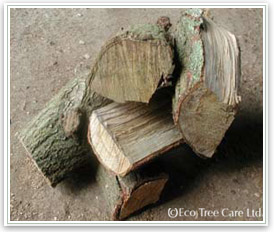
Pear
- Pyrus spp.
An excellent firewood, and a lovely log to look at and hold. Gives a good
heat and burns extremely well
Firewood Burning Properties
- Easy, hot, good-looking
Log frequency
: 2
Pine
- Pinus spp.
Not a bad firewood log when well seasoned. It has a unfair bad reputation
as it can occasionally spit because of the resin that it contains but in Scots
Pine at least the resin acts like a wax to the wood as a wick, resulting in
the flames being much fiercer and larger than one would expect. It does have
a good smell. An excellent quick pretty flame. A good addition to the fire
and welcome in any log pile, just ask someone from Scandinavia they like pine.
Firewood Burning Properties
- Aromatic, atmospheric, fierce, dancing
Log frequency
: 2
Plane
- Planus spp.
Very troublesome to split into logs, strong, and wiry. Not a bad firewood
though, not the best, but certainly not a bad one to have in the log pile
Firewood Burning Properties
- Pleasant, happy, ambling
Log frequency
: 1
Plum
- Prunus domestica
A good hot burning firewood akin to others of the Prunus genus. Heavy
and dense long lasting logs. Good smell.
Firewood Burning Properties
- Hot, fierce, heavy
Log frequency
: 2
Poplar -
Populus spp.
Must be well seasoned to be come even an average firewood. Not highly rated
as it has a tendency not to burn very well and smolders. Because it burns
slowly it is used for matchsticks.You certainly wouldn't want to have to make
a fire with just poplar, however if burned in combination with other well
seasoned, 'quicker' burners it burns okay, gives up its heat, and so all is
well as a firewood. It does make excellent kindling if split down, because
it is a slow burner, and holds its flame when dry.
Firewood Burning Properties
- Smouldering, smokey, slow
Log frequency
: 1
Robinia
- Robinia psuedoacacia
Good hot, slow burning golden firewood. Dense and heavy logs. Very pretty
grain.
Firewood Burning Properties
- Slow, hot, rich
Log frequency
: 1
Rhododendron
- Rhododendron ponticum
A surprisingly excellent firewood. Burns very very hot, with little ash. Does
burn quite quickly, good logs makes excellent charcoal. One of Ben Law's favourite
firewoods.
Firewood Burning Properties
- Rapid, blue, dynamic, hot, keen, vocal
Log frequency
: 1
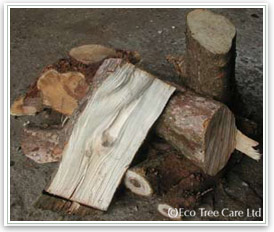
Rowan
- Sorbus aucuparia
Rowan makes a good hot fire, which burns slowly. Best in combination with
other firewood.
Firewood Burning Properties
- Hot, slow
Log frequency
: 2
Spruce
- Picea spp.
Lightweight logs tendency to burns very quickly with a crackles. Good smells
though. Useful in the mix with others which are slow to burn like oak logs.
Firewood Burning Properties
- Fast, crackling
Log frequency
: 3
Sweet Chestnut
- Castenea sativa
A good firewood when properly seasoned. It can spit especially if still a
little wet, which is why it has developed a bit of a bad reputation with a
few people. It is generally an underrated firewood that is an excellent hard,
dense firewood - good for wood burners where of course spitting is of no concern.
The thick bark means that it requires cutting and splitting into firewood
and seasoning for at least 2 years.
Firewood Burning Properties
- Fast, crackling
Log frequency
: 10
Sycamore
- Acer pseudoplatanus
A good firewood like the other acers. Splits well, and dries quickly. A common
'weed' tree to be dismantled and felled as it is quite invasive, grows very
quickly and does not make a good tree for small back gardens which is often
where it can be found, self-set, outgrowing its position and creating a lot
of shade with its large leaves. In its defence it is a magnificent tree in
parkland and field, it comes into its own when it has the space to grow to
maturity. Must be seasoned, not good at all green.
Firewood Burning Properties
- Bright, keen
Log frequency
: 5
Walnut
- Juglans regia
A poor to medium firewood, with a not so pleasant smell. Hard to get going.
Only marginally better than elm.
Firewood Burning Properties
- Soft, slow, smelly
Log frequency
: 4
Wild Service
Tree - Sorbus torminalis
Not unlike holly when it burns with a waxy quality. The flame is bright, yellow
and quick with blue/green flickering. It burns slowly to give a 'charcoal
briquette' which is long lasting and leaves little ash. Nice and hot. However
it is very very unlikely that it is found in a firewood pile, wild service
tree is one of the UK's rarest native trees, only occurring in semi-natural
ancient woodlands or where planted as a specimen tree. When they are discovered
in woodlands they are to be treasured, not cut down and logged up for firewood.
We only had some because we were looking after a woodland near Maldon in Essex
and a large branch from a Wild Service Tree had split off and blocked off
a main track.
Firewood Burning Properties
- Hot, bright, waxy
Log frequency
: 1
Willow
- Salix spp.
Logs must be seasoned very well to become an average firewood. Burns very
quickly with not a great amount of flame. If at all green it is completely
useless. When seasoned an excellent fire starter.
Firewood Burning Properties
- Quick, cool, light
Log frequency
: 3
Yew
- Taxus baccata
A slow burning firewood, the logs are dense and hard, gives off a great deal
of heat. Good aromatic smell.
Firewood Burning Properties
- Slow, considered, hot
Log frequency
: 5
Ultimately though, it is the quality of the seasoning, the splitting and the size that will give you a good fire. In the cold regions of our planet they have only conifers like pine and they manage to keep themselves warm and have got along just fine burning pine and spruce logs as firewood.
There are a few firewood rhymes that summerise the above
Beechwood fires are bright and clear
If the logs are kept a year
Chestnut only good they say
If for long it's laid away
Make a fire of elder tree
Death within your house will be
But ash new or ash old
Is fit for a Queen with a crown of gold
Birch and Fir logs burn too fast
Blaze up bright and do not last
It is by the Irish said
Hawthorn bakes the sweetest bread
Elmwood burns like churchyard mould
Even the very flames are cold
But ash green or ash brown
Is fit for a Queen with a golden crown
Poplar gives a bitter smoke
Fills your eyes and makes you choke
Apple wood will scent your room
With an incense-like perfume
Oaken logs, if dry and old
Keep away the winters cold
But ash wet or ash dry
A king shall warm his slippers by.
Beechwood fires burn bright
and clear
If the logs are kept a year
Store your beech for Christmastide
With new holly laid beside
Chestnuts only good they say
If for years tis stayed away
Birch and firewood burn too fast
Blaze too bright and do not last
Flames from larch will shoot up high
Dangerously the sparks will fly
But Ashwood green and Ashwood brown
Are fit for a Queen with a golden crown
Oaken logs, if dry and old
Keep away the winters cold
Poplar gives a bitter smoke
Fills your eyes and makes you choke
Elmwood burns like churchyard mould
Even the very flames burn cold
Hawthorn bakes the sweetest bread
So it is in Ireland said
Applewood will scent the room
Pears wood smells like a flower in bloom
But Ashwood wet and Ashwood dry
A King may warm his slippers by.
Logs to Burn, Logs to burn, Logs to burn,
Logs to save the coal a turn,
Here's a word to make you wise,
When you hear the woodman's cries.
Never heed his usual tale,
That he has good logs for sale,
But read these lines and really learn,
The proper kind of logs to burn.
Oak logs will warm you well,
If they're old and dry.
Larch logs of pine will smell,
But the sparks will fly.
Beech logs for Christmas time,
Yew logs heat well.
"Scotch" logs it is a crime,
For anyone to sell.
Birch logs will burn too fast,
Chestnut scarce at all.
Hawthorn logs are good to last,
If you cut them in the fall.
Holly logs will burn like wax,
You should burn them green,
Elm logs like smouldering flax,
No flame to be seen.
Pear logs and apple logs,
They will scent your room,
Cherry logs across the dogs,
Smell like flowers in bloom
But ash logs, all smooth and grey,
Burn them green or old;
Buy up all that come your way,
They're worth their weight in gold.


